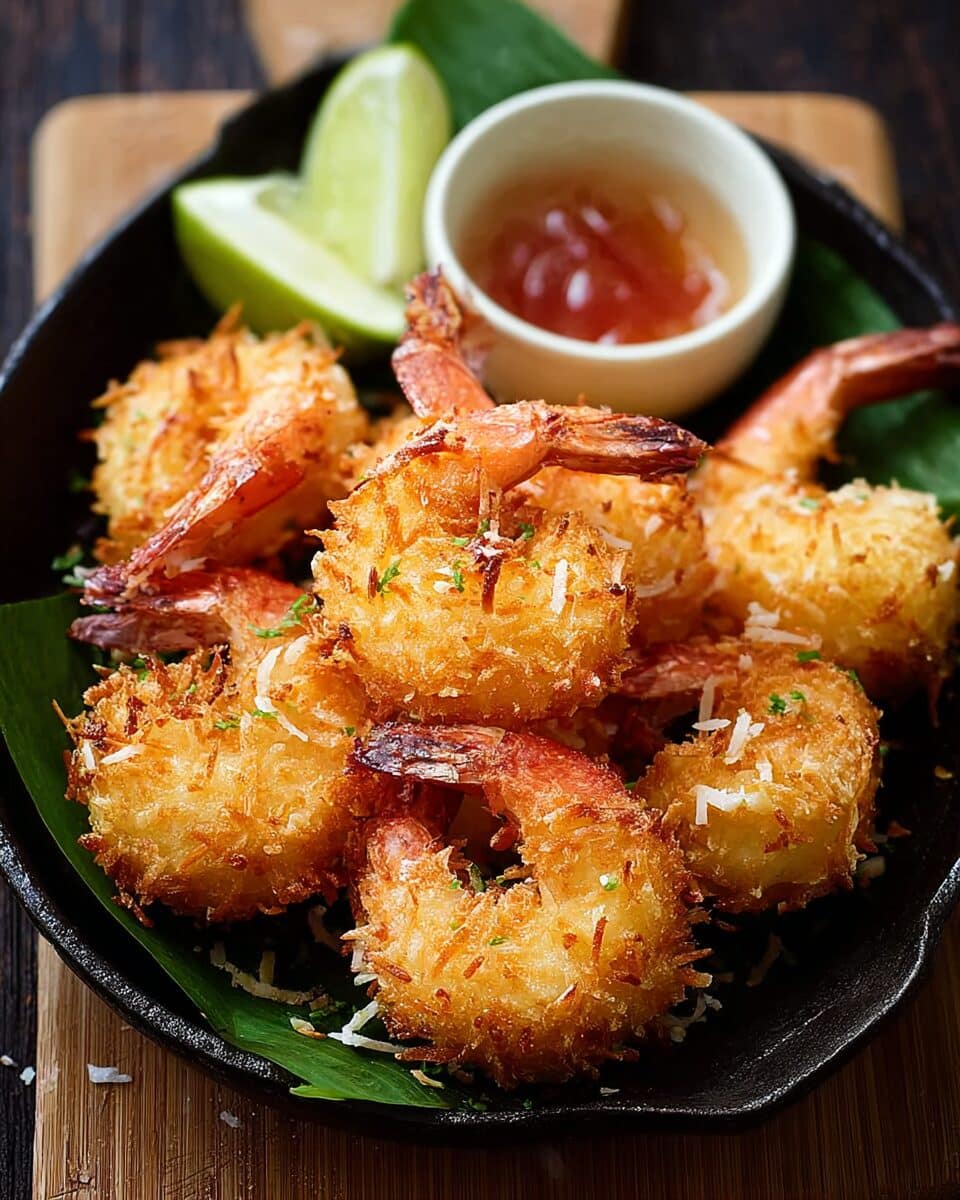The irresistible crunch of golden coconut shrimp is something every seafood lover needs to experience. Coated in a sweet and savory blend of panko breadcrumbs and shredded coconut, these shrimp are deep-fried to a perfect crisp. Served with a spicy tartar sauce that adds a kick of heat and creaminess, this dish balances indulgence with fresh, coastal flavors. Perfect for parties, appetizers, or a delicious dinner starter, they’re not just better than restaurant shrimp—they’re shockingly easy to make at home in just 20 minutes.
Full recipe:
Ingredients:
-
1 cup Japanese panko breadcrumbs (or regular breadcrumbs)
-
1/2 cup sweetened dessicated coconut flakes
-
1/2 lb (250g) jumbo shrimp or tiger prawns, peeled and deveined, tails on
-
2 eggs, beaten
-
2 teaspoons sugar
-
Oil for deep frying
For the Spicy Tartar Sauce:
-
1/2 cup mayonnaise
-
1/2 tablespoon chili sauce (or to taste)
-
1/2 tablespoon onion, finely minced
-
1/2 tablespoon celery, finely chopped
-
A squirt of lemon juice
Directions:
-
Preheat a deep fryer or heavy-bottomed pot of oil to 350°F (176°C).
-
In a shallow bowl, mix the panko breadcrumbs and coconut flakes.
-
In another bowl, whisk together the eggs and sugar.
-
In a small bowl, combine all the tartar sauce ingredients. Mix well and refrigerate until serving.
-
Pat the shrimp dry with paper towels.
-
Dip each shrimp into the egg mixture, then dredge in the panko-coconut mix to coat.
-
For extra crispiness, repeat the coating: dip again into the egg, then coat with the panko-coconut mixture.
-
Set the coated shrimp aside on a parchment-lined plate.
-
Carefully lower the shrimp into the hot oil and fry until golden brown on both sides.
-
Remove with a strainer and drain on paper towels.
-
Serve hot with the spicy tartar sauce on the side.
Prep Time: 10 minutes | Cooking Time: 10 minutes | Total Time: 20 minutes
Kcal: 391 kcal | Servings: 2 servings
The Allure of Coconut Shrimp: A Culinary Crowd-Pleaser
Coconut Shrimp is more than just a delicious appetizer — it’s a tropical-inspired dish that blends texture, flavor, and visual appeal in one bite-sized morsel. A crunchy, golden exterior conceals juicy shrimp, with sweet coconut flakes enhancing the savory profile. This recipe has been a restaurant favorite at places like Red Lobster and Outback Steakhouse, but making it at home is faster, cheaper, and even more satisfying.
Whether you’re serving it as a game-day appetizer, a party platter, or an indulgent dinner side, this Coconut Shrimp recipe stands out because of its simplicity and irresistible flavor. But what exactly makes it the best coconut shrimp recipe? Let’s explore.
A Brief History and Cultural Influence
Shrimp is a seafood staple found in cuisines across the globe, but Coconut Shrimp is particularly influenced by tropical and coastal cultures. Dishes combining coconut and seafood have long been popular in regions such as Southeast Asia, the Caribbean, and Polynesia.
The American version of Coconut Shrimp borrows heavily from these traditions, combining the crunch of fried food with the natural sweetness of coconut — an ingredient widely available in tropical zones. The result is a dish that feels exotic but approachable.
Its growing popularity in the U.S. and beyond reflects a broader appreciation for fusion flavors — sweet and savory, crunchy and tender. This version of Coconut Shrimp, especially when paired with a spicy tartar dipping sauce, perfectly represents the evolution of global food influences meeting everyday cooking convenience.
Why This Coconut Shrimp Recipe Stands Out
There are countless Coconut Shrimp recipes out there, but this one has been fine-tuned to deliver maximum crunch, flavor, and visual appeal in under 20 minutes. Here’s why it’s a cut above the rest:
-
Double Coating for Extra Crunch: Unlike single-dip recipes, this method involves dipping the shrimp twice — once into the egg mixture and then into the panko-coconut mixture — ensuring a thick, crisp layer that stays crunchy even after frying.
-
Sugar in the Egg Mixture: This simple yet genius trick adds a hint of sweetness that enhances the coconut flavor, without being overly sugary. Each bite tastes balanced — not bland, not overly sweet.
-
Spicy Tartar Sauce: Most Coconut Shrimp recipes stop at the fry. This one elevates the dish with a homemade dipping sauce that blends creamy mayo with chili sauce, lemon juice, and aromatic vegetables like onion and celery. It cuts through the richness beautifully.
-
Simple Ingredients, Big Flavor: With only a handful of pantry staples — eggs, panko, coconut flakes, shrimp — this recipe is incredibly accessible while delivering restaurant-quality results.
Ingredients and Their Benefits
Let’s break down what makes each component of this dish shine — not just in taste, but in nutritional or functional value as well:
-
Shrimp: Low in calories and high in protein, shrimp is also a great source of selenium, iodine, and vitamin B12. It’s naturally sweet and juicy, making it perfect for deep frying without getting dry.
-
Coconut Flakes: Coconut adds texture and tropical sweetness, but it also comes with healthy fats known as MCTs (medium-chain triglycerides) which may aid digestion and metabolism in moderation.
-
Panko Breadcrumbs: These Japanese breadcrumbs are lighter and flakier than regular ones, helping the coating stay airy and crisp rather than dense.
-
Eggs and Sugar: Eggs help the coating stick, while sugar brings out the natural sweetness in coconut and shrimp alike. It’s a small touch with a big impact.
-
Spicy Tartar Sauce: This brings everything together with creamy richness, tangy brightness from lemon juice, and a spicy kick. The sauce adds complexity and contrast — a must-have companion to fried dishes.
Tips for Perfecting the Dish
Even though this Coconut Shrimp recipe is simple, a few key tips can take it from good to spectacular:
-
Use Jumbo or Tiger Prawns: Bigger shrimp not only make for a more satisfying bite, but they also hold up better to frying without becoming rubbery.
-
Dry Your Shrimp Thoroughly: Moisture is the enemy of crispiness. Use paper towels to pat shrimp dry before dipping.
-
Don’t Overcrowd the Fryer: Fry in batches so the oil temperature doesn’t drop. This ensures even browning and crisp texture.
-
Serve Immediately: Coconut Shrimp tastes best hot and fresh, when the crust is at its crispiest and the shrimp is still juicy.
-
Customize Your Dip: You can swap the tartar base with yogurt for a lighter feel, or use sriracha instead of chili sauce for more heat.
When and How to Serve Coconut Shrimp
Coconut Shrimp fits into multiple meal categories. It’s ideal as:
-
An Appetizer: Serve it on skewers for a fun party bite.
-
A Side Dish: Pair it with a light salad or slaw to balance the richness.
-
A Main Course: Serve over jasmine rice or coconut rice with a drizzle of extra dipping sauce.
-
A Game-Day Snack: Coconut Shrimp holds its crunch well, making it ideal for sharing during events.
To elevate the presentation, garnish with chopped cilantro, fresh lime wedges, or even pineapple salsa for a colorful, tropical twist.
Make It Your Own: Variations to Try
Once you’ve mastered the base recipe, consider these variations:
-
Baked Coconut Shrimp: Bake at 400°F for 15 minutes for a lighter, oil-free version.
-
Air-Fried Version: Set your air fryer to 375°F for about 8–10 minutes, flipping halfway through.
-
Gluten-Free Option: Use gluten-free panko or crushed rice crackers instead of breadcrumbs.
-
Spicy Lovers’ Edition: Add cayenne pepper to the coconut coating for heat, or spike the dipping sauce with sriracha.
These variations let you tailor the recipe to your dietary preferences or culinary curiosity.
Is It Healthy? Understanding the Nutrition
While fried food isn’t usually considered “healthy,” this recipe is far from empty calories. With protein-rich shrimp and fiber-packed coconut, it offers some nutritional value alongside its indulgence.
One serving comes in at approximately 391 kcal with 33g of protein — making it a satisfying option for those who want to indulge without straying too far from balanced eating.
Opting for air-frying or baking reduces the fat content significantly. Pairing Coconut Shrimp with a side of greens or a vinegar-based slaw also helps balance the meal.
Storing and Reheating Leftovers
Coconut Shrimp is best eaten fresh, but you can store leftovers in an airtight container in the refrigerator for up to 2 days.
To reheat:
-
Oven: Bake at 375°F for 8-10 minutes.
-
Air Fryer: 350°F for 5-6 minutes until crispy.
-
Avoid the microwave — it will make the coating soggy.
If you’ve made extra dipping sauce, it can be stored for 3–4 days in the fridge in a sealed container.
Perfect Pairings for Coconut Shrimp
If you’re planning a menu or entertaining guests, here are some dishes that complement Coconut Shrimp beautifully:
-
Coconut Rice or Pineapple Fried Rice
-
Fresh Mango Salsa or Pineapple Chutney
-
Grilled Vegetables with Lime
-
Crisp Garden Salad with Balsamic Vinaigrette
-
Chilled White Wine or Tropical Cocktails (like Piña Colada or Mojito)
These accompaniments amplify the tropical vibe and add balance to the richness of the shrimp.
Conclusion
Coconut Shrimp is a timeless classic that brings tropical flair to any table. This recipe, in particular, delivers unmatched crunch, juiciness, and flavor — all with simple, affordable ingredients. With tips to perfect the coating, a spicy homemade sauce to elevate every bite, and versatile serving ideas, it’s a dish that can be made on a whim but remembered forever.
Whether you’re hosting a summer gathering, looking for a new family favorite, or simply indulging in a coastal craving, this Coconut Shrimp recipe has everything you need. And with its fast cooking time and foolproof method, it just might become your go-to seafood snack.






